Ancient Chinese Warfare › Ancient Chinese Art » Ancient origins
Articles and Definitions › Contents
- Ancient Chinese Warfare › Ancient History
- Ancient Chinese Art › Ancient History
Ancient civilizations › Historical and archaeological sites
Ancient Chinese Warfare › Ancient History
Definition and Origins

In ancient China warfare was a means for one region to gain ascendancy over another, for the state to expand and protect its frontiers, and for usurpers to replace an existing dynasty of rulers. With armies consisting of tens of thousands of soldiers in the first millennium BCE and then hundreds of thousands in the first millennium CE, warfare became more technologically advanced and ever more destructive. Chariots gave way to cavalry, bows to crossbows and, eventually, artillery stones to gunpowder bombs. The Chinese intelligentsia may have frowned upon warfare and those who engaged in it and there were notable periods of relative peace but, as in most other ancient societies, for ordinary people it was difficult to escape the insatiable demands of war : either fight or die, be conscripted or enslaved, win somebody else's possessions or lose all of one's own.
ATTITUDES TO WARFARE
The Chinese bronze age saw a great deal of military competition between city -rulers eager to grab the riches of their neighbours, and there is no doubt that success in this endeavour legitimised reigns and increased the welfare of the victors and their people. Those who did not fight had their possessions taken, their dwellings destroyed and were usually either enslaved or killed. Indeed, much of China's history thereafter involves wars between one state or another but it is also true that warfare was perhaps a little less glorified in ancient China than it was in other ancient societies.
"NO COUNTRY HAS EVER PROFITED FROM PROTRACTED WARFARE” - SUN-TZU.
The absence of a glorification of war in China was largely due to the Confucian philosophy and its accompanying literaturewhich stressed the importance of other matters of civil life. Military treatises were written but, otherwise, stirring tales of derring-do in battle and martial themes, in general, are all rarer in Chinese mythology, literature and art than in contemporary western cultures, for example. Even such famous works as Sun-Tzu's The Art of War (5th century BCE) warned that, "No country has ever profited from protracted warfare” (Sawyer, 2007, 159). Generals and ambitious officers studied and memorised the literature on how to win at war but starting from the very top with the emperor, warfare was very often a policy of last resort. The Han dynasty (206 BCE - 220 CE) was notable for its expansion, as were some Tang dynasty emperors (618-907 CE) but, in the main, a strategy of paying off neighbours with vast tributes of silver and silk, along with a parallel exportation of “civilising” culture was seen as the best way to defend imperial China's borders. Then, if war ultimately proved unavoidable, it was better to recruit foreign troops to get on with it.
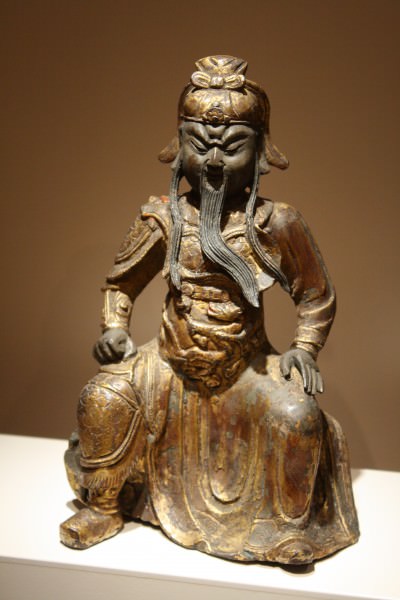
Kuan Ti
Joining the intellectuals with their disapproval of warfare were also the bureaucrats who had no time for uncultured military men. No doubt, too, the vast majority of the Chinese peasantry were never that keen on war either for it was they who had to endure conscription, heavy taxes in kind to pay for costly campaigns, and have their farms invaded and plundered.
With the emperors, the landed gentry, intellectuals and farmers all well-aware of what they could lose in war, it was, then, somewhat disappointing for them all that China, in any case, had just as many conflicts as anywhere else in the world in certain periods. One cannot ignore the common presence of fortifications in the bronze age, such chaotic centuries as the Autumn and Spring period (722-481 BCE) with its one hundred plus rival states, the Warring States period (481-221 BCE) with its incredible 358 separate conflicts or the fall of the Han when war was once again incessant between rival Chinese states. Northern steppe tribes were also constantly prodding and poking at China's borders and emperors were not averse to the odd foreign folly such as attacking ancient Korea.
WEAPONS
The great weapon of Chinese warfare throughout its history was the bow. The most common weapon of all, skill in its use was also the most esteemed. Employed since the Neolithic period, the composite version arrived during the Shang dynasty (c. 1600-1046 BCE) and so became a much more useful and powerful component of an army's attack strategy. Bowmen often opened up the battle proceedings by firing massed volleys into the enemy and then protected the flanks of the infantry as they advanced, or their rear when they retreated. Bowmen also rode in chariots and bows were the main weapon of cavalry.
Perhaps the most distinctive and symbolic weapon of Chinese warfare was the crossbow. Introduced during the Warring States period it set China apart as a nation capable of technical innovation and the training necessary to use it effectively. The Han used it to great effect against “barbarian” tribes to expand their empire, their disciplined crossbow corps even seeing off opposing cavalry units. As with bowmen, crossbowmen were usually stationed at the flanks of infantry units. Over the centuries new designs made the crossbow lighter, able to be cocked using one hand, fire multiple bolts and fire them further, more accurately and with more power than before. Artillery versions were developed which could be mounted on a swivel base. Apart from its potential as an offensive weapon, the crossbow became a much-used means of defending well-fortified cities.
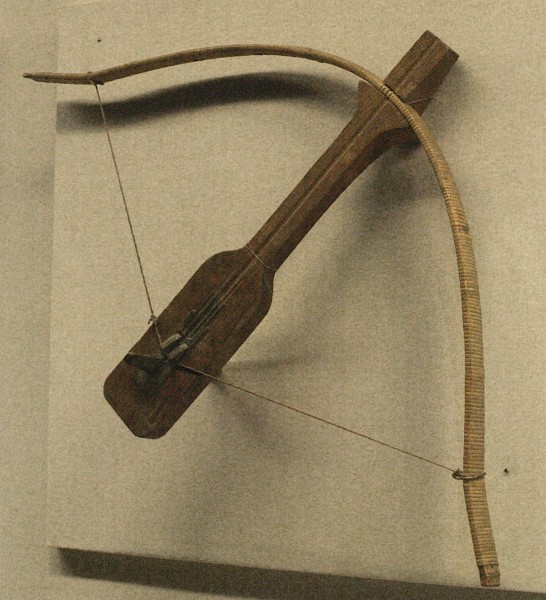
Qin Dynasty Crossbow
Swords only appeared relatively late on Chinese battlefields, probably from around 500 BCE, and never quite challenged the bow or crossbow as the prestige weapons of Chinese armies. Developing from long-bladed daggers and spearheads which were used for stabbing, the true sword was made from bronze and then, later, iron. During the Han period they became more effective with better metalworking techniques giving stronger blades with sharper cutting edges. Other weapons used by Chinese infantry included the ever-popular halberd (a mix of spear and axe), spears, javelins, daggers, and battle-axes.
Artillery was present from the Han period when the first stone-throwing, single-armed catapults were used. They were probably mostly restricted to siege warfare but were employed by both attackers and defenders. The more powerful counter-weighted catapult was not used in China until the 13th century CE. Artillery fired stones, missiles made of metal or terracotta, incendiary bombs using naphtha oil of “ Greek fire ” (from the 10th century CE) and, from the Sung dynasty (960-1279 BCE), bombs using gunpowder. The oldest text reference to gunpowder dates to 1044 CE while a silk banner describes its use in the 9th century CE (if its dating is accurate). Gunpowder was never fully exploited in ancient China and devices using it were restricted to missiles made with a soft casing of bamboo or paper which were designed to start fires on impact. The true bomb, which dispersed lethal fragments on explosion, was not seen until the 13th century CE.
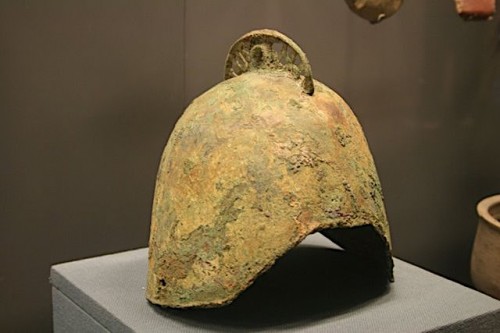
Warring States Helmet
ARMOUR
With arrows and crossbow bolts becoming ever more lethal, it is no surprise that armour made leaps forward in design to better protect warriors. The earliest armour was undoubtedly the most impressive - tiger skins, for example - but also the least effective and by the Shang dynasty hardened leather was being worn to cover the chest and back in a more serious effort to dampen and deflect blows. By the Zhou dynasty (1046-256 BCE) more flexible armour tunics were being produced made of rectangles of tanned and lacquered leather or bronze linked together with hemp or riveted. Examples of this type can be seen in the Qin warriors of the Terracotta army of the 3rd century BCE. From the Han period, iron was used more and more in armour.
HELMETS & ARMOUR, ON OCCASION, WERE DECORATED WITH PLUMES, ENGRAVINGS & PAINTINGS OF FEARSOME CREATURES.
Additional protection was provided by shields, the earliest being made only of bamboo or leather but then, like body armour, they began to incorporate metal elements. Helmets followed the same path of material evolution and usually protected the ears and back of the neck. Helmets and armour, on occasion, were decorated with plumes, engravings and paintings of fearsome creatures or beautified with additions in precious metal or ivory. Specialised armour developed for warriors in chariots who did not need to move so much and could wear full-length armoured coats. There was, too, heavy cavalry where the legs of the rider and the whole horse were protected.
CHARIOTS & CAVALRY
Chariots were used in Chinese warfare from around 1250 BCE but were seen in the greatest numbers between the 8th and 5th century BCE. First as a commander's status symbol and then as a useful shock weapon, the chariot usually carried a rider, bowman and spearman. They were very often deployed in groups of five. Pulled by two, three or four horses, they came in different versions - light and fast for moving troops around the battlefield, heavy bronze and armoured versions for punching holes in enemy ranks, those converted to carry fixed heavy crossbows, or even towered versions for commanders to better view the battle proceedings. The chariot corps could also pursue an army in retreat. Needing a wide area to turn and flat ground to function, the limitations of chariots meant they were eventually replaced by cavalry from the 4th century BCE onwards.

Chinese Qin Chariot
Cavalry was probably an innovation from the northern steppe tribes which the Chinese realised offered much more speed and mobility than chariots. The problem was to acquire the skill not only to ride the horses but also to fire weapons from them when the saddle was not much more than a blanket and the stirrup had yet to be invented. For these reasons, it was not until the Han period that cavalry became an important component of a field army. Cavalry riders were armed with a bow, lance, sword or halberd. Like chariots, cavalry was used to protect the flanks and rear of infantry formations, as a shock weapon and as a means to harass an enemy on the move or conduct hit-and-run raids.
FORTIFICATIONS
Surrounding a settlement with a protective ditch (sometimes flooded to make a moat) dates back to the 7th century BCE millennium BCE in China and the building of fortification walls using dried earth dates to the late Neolithic period. Siege warfare was not a common occurrence in China, though, until the Zhou dynasty when warfare entailed the total destruction of the enemy as opposed to just their army. By the Han period, city walls were commonly raised to a height of up to six metres and made of compacted earth. Crenellations, towers and monumental gates were another addition to a city's defence. Walls also became more weather resistant by covering the lower parts in stone to withstand local water sources being re-directed by an attacking force in order to undermine the wall. Another technique to strengthen walls was to mix in pottery sherds, plant material, branches and sand with the earth. Ditches up to 50 metres wide, often filled with water, and even a double ring of circuit wall were other techniques designed to ensure a city could withstand attack long enough for a relieving force to arrive from elsewhere.

The Great Wall of China
Not only cities but state frontiers were protected by high walls and watchtowers. The earliest may have been in the north from the 8th century BCE but the practice became a common one in the Warring States period when many different powerful states vied for control of China. Most of these structures were dismantled by the victor state, what would become the Qin dynastyfrom 221 BCE, but one wall was greatly expanded to become the Great Wall of China. Extended again by subsequent dynasties, the wall would eventually stretch some 5,000 km from Gansu province in the east to the Liaodong peninsula. The structure was not continuous but it did, for several centuries, help protect China's northern frontier against invasion from nomadic steppe tribes.
ORGANISATION & STRATEGIES
China's history is an extremely long one and each time period and dynasty saw its own practices and innovations in warfare.Still, some themes run through the history of warfare in China. Officers were often professionals (although they commonly inherited their status), ordinary troops were conscripts or captured soldiers; convicts could also be pressed into service. There were also volunteers, typically young men from noble families who joined as cavalrymen looking for adventure and glory. The organisation of an army in the field into three divisions had a long tradition. So, too, did the five-man unit, typically applied to infantry where squads were composed of two archers and three spearmen. By the Warring States period, an army was typically divided into five divisions, each represented by a flag which denoted its function:
- Red Bird - Vanguard
- Green Dragon - Left Wing
- White Tiger - Right Wing
- Black Tortoise - Rear Guard
- Great Bear Constellation - Commander & Bodyguard
When the crossbow became more common troops proficient with that weapon often formed an elite corps and other specific units were used as shock troops to help out where needed or confuse the enemy. As already noted above, archers and cavalry protected the flanks of heavier infantry and chariots, when used, could fulfill the same function or bring up the rear. Such positions, which are described as ideals in the military treatises, are confirmed by the Terracotta Army of Shi Huangti. Flags, unit banners, drums and bells were used on the battlefield to better organise troops and deploy them in the manner the commander wished.
Supporting the soldiers were dedicated officers responsible for logistics and supplying the army with the necessary food (millet, wheat and rice), water, firewood, fodder, equipment and shelter they needed while on campaign. Material was transported by river whenever possible and if not, on ox carts, horses and even wheelbarrows from the Han period onward.From the Warring States period, and especially the Han period, portions of armies were set the task of farming so as to acquire the necessary vitals that foraging, confiscation from locals or capture from the enemy could not supply. The establishment of garrisons with their own food production and improvements in supply roads and canals also went a long way to lengthening the time an army could effectively stay in the field.
Full-on infantry battles, cavalry skirmishes, reconnaissance, espionage, subterfuge, and ambush were all present in Chinese warfare. Much was made of gentlemanly etiquette in war during the Shang and Zhou periods but this was likely an invention of later writers or at best an exaggeration. Certainly, when warfare became more mobile and the stakes made higher from the 4th century BCE, a commander was expected to win with and by any means at his disposal.
One final theme which runs through much of China's history is the use of expert diviners who could study omens, observe the movement and position of celestial bodies, gauge the meaning of natural phenomena and consult calendars all in order to determine the most auspicious time and place to engage in warfare. Without these considerations, it was believed, the best weapons, men and tactics would not be enough to bring final victory.
Ancient Chinese Art › Ancient History
Definition and Origins
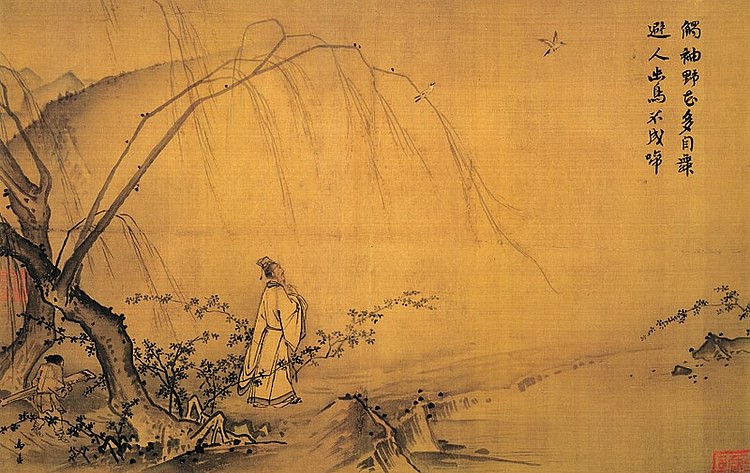
Ancient China covered a vast and ever-changing geopolitical landscape, and the art it produced over three millennia is, unsurprisingly, just as varied. Still, despite continuous indigenous technical developments, changes in materials and tastes, and the influence of foreign ideas, there are certain qualities inherent in Chinese art which make it possible to describe in general terms and recognise no matter where or when it was produced and for what purpose. These essential qualities include a love of nature, a belief in the moral and educative capacity of art, an admiration of simplicity, an appreciation of accomplished brushwork, an interest in viewing the subject from various perspectives, and a loyalty to much-used motifs and designs from lotus leaves to dragons. Chinese art would influence tremendously that of its neighbours in East Asia, and the worldwide appreciation of its accomplishments, especially in ceramics, painting, and jade work continue to this day.
THE PURPOSE OF ART
An important difference between China and many other ancient cultures is that a large proportion of Chinese artists were not professionals but gentlemen amateurs (and a few ladies) who were also scholars. Students of Confucius and its sober principles, they were often men of literature who published poetry. Art was, for them and their audience, a means to capture and present the philosophical approach to life which they valued. For this reason, the art they produced is often minimal and without artifice, perhaps sometimes even a little austere to western eyes. Art, throughout most of China's history, was meant to express the artist's good character and not merely be an exposition of his practical artistic skills. Such Confucian principles as propriety or li were looked for by many of those who produced and consumed art.
THE REAL ARTS OF MERIT IN CHINA WERE CALLIGRAPHY & PAINTING.
Naturally, there were professional artists too, employed by the Imperial court or wealthy patrons to decorate the walls and interiors of their fine buildings and tombs. Of course, there were, too, thousands of craftsmen working precious materials into objects of art for the few who could afford them, but these were not regarded as artists in the modern sense. The real arts of merit in China were calligraphy and painting. If the art world today is troubled by a certain snobbishness, then the Chinese were perhaps the first to succumb to questions of what is and what is not art.
There grew up in China a connoisseurship of art so that more and more people became collectors of it. Texts were printed to guide people on the history of Chinese art with helpful rankings of the various merits of past artists. In a certain way, art became somewhat standardised with conventions to be adhered to. Artists were expected to study the great masters, copying their works as part of their training. One of the most famous and long-lasting sources of advice on judging art is the six-point list of the 6th century CE art critic and historian Xie He, originally published in his now lost Old Record of the Classifications of Painters. When considering the merits of a painting the viewer should assess the following (with point 1 the most important and essential):
- Spirit Resonance, which means vitality.
- Bone Method, which means using the brush.
- Correspondence to the object, which means depicting the forms.
- Suitability to type, which has to do with laying on of colour.
- Division and planning, that is, placing and arranging.
- Transmission by copying, that is, the copying of models. (Tregear, 94)
These relatively rigid rules of art creation and appreciation were, then, largely due to the belief that art should somehow benefit the viewer. The idea, or better, the acceptance that art could and should express the feelings of the artists themselves would only arrive in more modern times. Still, that is not to say there were not, just as in any art anywhere in the world, eccentrics who ignored the conventions and created works in their own inimitable way. There are cases in China of artists who painted to music not even looking at the picture, one who only painted when drunk and used his cap instead of a brush, those who used their fingers or toes to paint, and even one action artist who splashed ink on the silk spread out on his studio floor and then dragged an assistant over it. Sadly, the results of these innovations have not survived to be enjoyed today in the world's museums of Asiatic art.
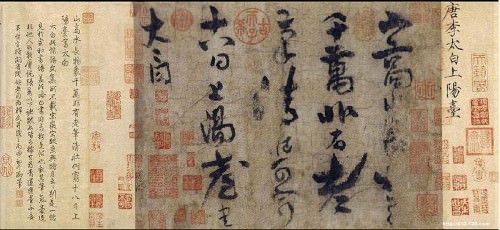
Li Po's Calligraphy
CALLIGRAPHY
The art of calligraphy - and for the ancient Chinese it certainly was an art - aimed to demonstrate superior control and skill using brush and ink. Calligraphy established itself as one of the major Chinese art forms during the Han dynasty (206 BCE - 220 CE), and for two millennia after, all educated men were expected to be proficient at it. Some women, or at least certain figures at court, did become known as accomplished calligraphers, most notably Lady Wei (272-349 CE), said to have taught the great master Wang Xizhi (303-361 CE).
Far more than mere writing, the art used varying thicknesses of brushstroke, their subtle angles, and their fluid connection to each other - all precisely arranged in imaginary spaces on the page - to create an aesthetically pleasing whole. A connoisseurship quickly developed, and calligraphy became one of the six classic and ancient arts alongside ritual, music, archery, charioteering, and numbers.
The techniques and conventions of writing would influence painting where critics looked for the artist's forceful use of brushstrokes, their spontaneity, and their variation to produce the illusion of depth. Another influence of calligraphy skills on painting was the importance given to composition and the use of blank space. Finally, calligraphy remained so important that it even appeared on paintings to describe and explain what the viewer was seeing, indicate the title (although by no means all paintings were given a title by the original artist) or record the place it was created and the person it was intended for.Eventually, such notes and even poems became an integral part of the overall composition and an inseparable part of the painting itself. There was a fashion, too, for adding more inscriptions by subsequent owners and collectors, even adding extra portions of silk or paper to the original piece to accommodate them. From the 7th century CE owners frequently added their own seal in red ink, for example. Chinese paintings it seems were meant to be perpetually handled and embellished with fine calligraphy.
PAINTING
Chinese painters painted on various materials in many formats. The most popular formats were on walls (from c. 1100 BCE), coffins and boxes (from c. 800 BCE), screens (from c. 100 CE), silk scrolls which were designed to be looked at in the hand or hung on walls (from c. 100 CE for horizontal and from c. 600 CE for vertical), fixed fans (from c. 1100 CE), book covers (from c. 1100 CE) and folding fans (from c. 1450 CE).
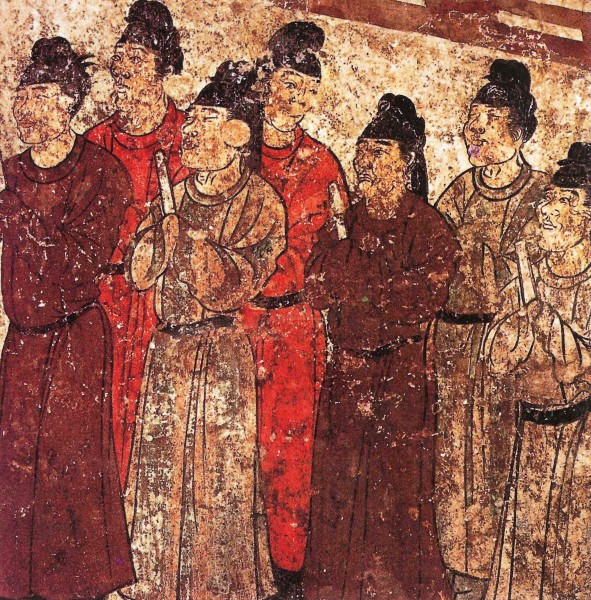
Chinese Eunuchs
The most popular materials with the earliest artists were wood and bamboo but then the following were adopted: plastered walls (from c. 1200 BCE), silk (from c. 300 BCE), and paper (from c. 100 CE). Canvas would only be used widely from the 8th century CE. Brushes were made from animal hair, cut to a tapering end and tied to a bamboo or wood handle. Significantly, they were precisely the same instruments used by the calligrapher. The inks used were made from rubbing a dried cake of animal or vegetable matter mixed with minerals and glue against a wet stone. Each artist had to laboriously make their own inks as there was no commercial production of them.
THE TWO MOST POPULAR THEMES OF CHINESE PAINTING WERE PORTRAITS & LANDSCAPES.
The two most popular themes of Chinese painting were portraits and landscapes. Portraits in Chinese art began in the Warring States Period (5th-3rd century BCE) and were traditionally rendered with great restraint, usually because the subject was a great scholar, monk or court official and so should, by definition, have a good moral character which should be portrayed with respect by the artist. For this reason, faces are often seemingly impassive with only the merest hint of emotion or character subtly expressed. Often the character of the subject is much more clearly expressed in their attitude and relationship to other people in the picture; this is especially true of portraits of emperors and Buddhist figures.
There were, however, instances of more realistic portraits and these can be seen particularly in the wall paintings of tombs. A branch of portraiture was to paint historical figures in certain instructive scenes from their life which showed the benefits of moral behaviour. Naturally, there were also paintings of people which had less lofty aims, and these include the popular scenes of Chinese family life which are usually set in a garden.
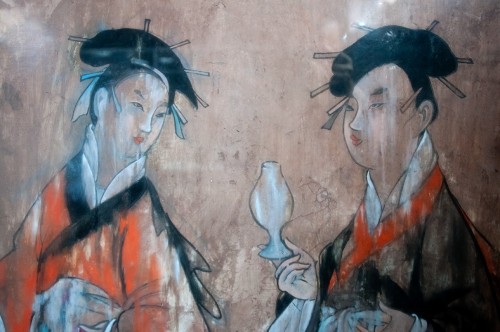
Han Women, Dahuting Tomb.
Landscape painting had been around as long as artists had, but the genre really took off during the Tang dynasty when artists became much more concerned with humanity's place in nature. Typically, small human figures guide the viewer through a panoramic landscape of mountains and rivers in Tang paintings. It should be no surprise that mountains and water dominated landscape painting as the very word in Chinese for landscape translates literally as “mountain-and-water”. Trees and rocks are also featured and the whole scene is usually meant to capture a particular season of the year. Colours were limited in use, either everything in various shades of a single colour (illustrating the roots in calligraphy) or two colours combined, usually blues and greens.
In accordance with the Taoist belief in the benefit of contemplating serene nature, there is rarely anything to disturb the tranquillity of landscape paintings such as farm labourers and no specific location is intended to be depicted. Later periods would, though, see more intimate and abstract scenes of nature concentrating on very specific themes such as bamboo gardens. Detailed paintings of a single animal, flower, or bird were especially popular from the Song dynasty (960-1279 CE) onwards, but these were regarded as artistically inferior to the other categories of Chinese painting.
Still, certain animals became symbolic of certain ideas and appeared in paintings just as they had already in other art forms like bronze work. For example, a pair of mandarin ducks denoted a happy marriage, a deer stood for money, and fish for fertility and abundance. Similarly, plants, flowers, and trees had their own meanings. Bamboo grows straight and true like a good scholar should be, the pine and cypress represent endurance, peaches long life, and each season had its own flower: peony, lotus, chrysanthemum, and prunus.
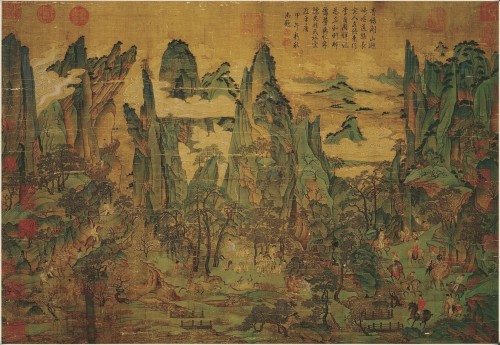
The Emperor Ming Huang Travelling in Shu
Depth was achieved in paintings by introducing mist or a lake in the middle ground giving the illusion that the mountains are further behind. Other devices include using paler ink and fainter strokes to paint more distant objects while foreground objects are rendered darker and more detailed. Painting the scene with several different viewpoints and multiple perspectives is another common characteristic of Chinese painting. One of the most famous of all Chinese landscape paintings is the 8th century CE painted silk panorama known as 'The Emperor Ming Huang Travelling in Shu'. It is a sprawling and detailed masterpiece of mountain scenery in the typical Tang style using only blues and greens. The original is lost but a later copy can be seen at the Palace Museum of Taipei.
SCULPTURE
Large-scale figure sculpture has not survived well but some monumental examples can still be seen such as those cut from the rock face at the Longmen Caves, Fengxian temple near Luoyang. Dating to 675 CE the 17.4 metre high figures represent a Buddhist Heavenly King and demon guardians. Another celebrated example of Chinese sculpture on a life-size scale are the figures of Shi Huangti ’s “ Terracotta Army ”. Over 7,000 figures of warriors, 600 horses and several chariots were set to guard the tomb of the 3rd-century BCE Qin emperor. Much effort was made to render each figure unique despite them all being made from a limited repertoire of assembled body parts made from moulds. Faces and hair, in particular, were modified to give the illusion of a real army composed of unique individuals.
Regarding smaller-scale works, the Shang Dynasty (c. 1600-1046 BCE) is famous for its cast bronze work. Common shapes of bronze vessels are three-legged cauldrons, sometimes with the legs made into animals, birds, or dragons. They can be circular or square, and many have lids and handles. Sharp relief decoration includes repeating patterns, masks, and scroll motifs. The Shang artists also produced vessels in the form of three-dimensional animals such as rams, elephants, and mythological creatures.
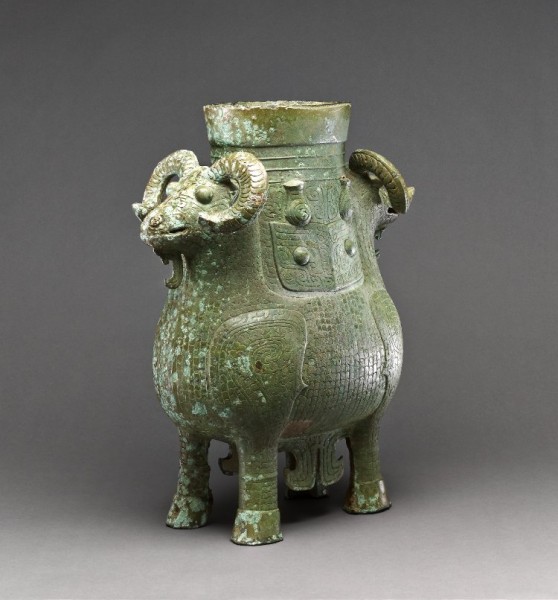
Shang Dynasty Bronze Zun
In the Han period, small-scale sculpture took the form of stone or bricks stamped and carved with relief scenes and they are particularly common in tombs. Outstanding examples come from the Wu Liang Shrine at Jiaxiang. Dating to 151 CE or 168 CE, there are some 70 relief slabs which carry scenes of battles and famous historical figures, such as Confucius, all identified by accompanying texts and covering a chronological Chinese history in a pictorial record similar to a history book.
BY THE TANG DYNASTY, THE WEALTH OF THE BUDDHIST MONASTERIES PERMITTED A GREAT PRODUCTION OF RELIGIOUS ART.
Also in the Han period, cast bronze sculptures of horses were popular. These are usually depicted in full gallop with only one hoof resting on the base so that they almost appear to be flying. Earthenware figurines of single standing women, men, and servants are common from the Han period. Cast bronze was used to make small figurines and ornate incense burners. These were often inlaid with gold and silver or gilded. One superb piece is a gilded bronze oil-lamp in the form of a kneeling servant girl, which dates to the late 2nd century BCE.
While the tombs of emperors and important people sometimes had large figure statues set outside them most later sculpture was of Buddhist subjects. By the time of the Tang dynasty, the wealth of the Buddhist monasteries permitted a great production of religious art. The most popular subjects, as ever, were the Buddha and bodhisattvas, and they ranged from miniature figurines to life-size statues. Unlike in previous periods, figures became much less static, their suggested flowing movement even drawing criticism from some that serious religious figures, on occasion, now looked more like court dancers.
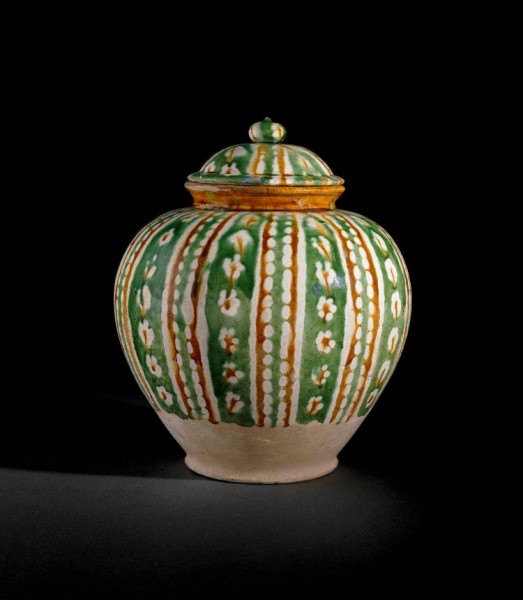
Tang Three-colour Glaze Jar
POTTERY
The Chinese were the masters of pottery and ceramics. They produced everything from heavy and functional storage jars in earthenware to exquisitely decorated bowls in the most delicate of porcelain, from vases to garden stools, teapots to pillows.They produced the first glaze wares, the first green celadons and the first underglaze wares painted with cobalt blue. Early developments in techniques and kilns led to both higher firing temperatures and the first glazed pottery during the Han period.Pottery, especially the vessels painted with a grey slip commonly found in Han tombs, very often imitated the shape and decoration of bronze vessels, and this would be a goal of many potters in later periods. Clay was used to produce small unglazed models of ordinary houses which were set in tombs to accompany the dead and, presumably, symbolically meet their need for a new home. Many such models are complete with adjacent animal pen and figurines of their occupants and animals.
Tang potters reached a level of technical proficiency greater than any of their predecessors. New colour glazes which were developed in the period included blues, greens, yellows, and browns, which were produced from cobalt, iron, and copper.Colours were mixed, too, producing the three-coloured wares the Tang period has become famous for. Rich inlays of gold and silver were also sometimes used to decorate Tang ceramics. In the Yuan (1271-1368 CE) and Ming (1368-1644 CE) periods even more famous ceramics would be produced with their distinctive and much-copied blue on white decoration which itself copied earlier Chinese paintings for design ideas.
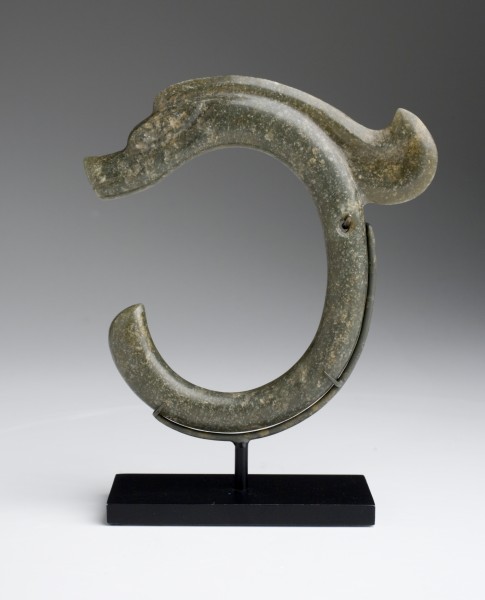
Hongshan Jade Dragon
MINOR ARTS
Gold, silver, copper, bronze, ivory, coloured glass, enamel, precious stones, semi-precious hard stones, silk, wood, and amberwere all materials transformed into art objects by gifted craftsmen, but perhaps the most quintessential Chinese materials of the minor arts were jade and lacquer. Jade was especially esteemed in China for its rarity, durability, purity, and association with immortality. Using circular cutting drills and iron tools, the hard material was carved into all manner of jewellery items, everyday objects and figurines of animals, people, and mythical creatures, especially dragons. Jade was especially used for ritual objects such as the bi disc and zong ( cong ) tubes, both of which were made in large numbers but are of unknown function. One unique but stunning use of jade was the creation of 'suits' to cover the body of the deceased in Han royal tombs.The 'suits' cover the contours of the body and are made from up to two thousand individually carved rectangular pieces of jade stitched together using gold or silver wire.
LICENSE:
Article based on information obtained from these sources:with permission from the Website Ancient History Encyclopedia
Content is available under License Creative Commons: Attribution-NonCommercial-ShareAlike 3.0 Unported. CC-BY-NC-SA License